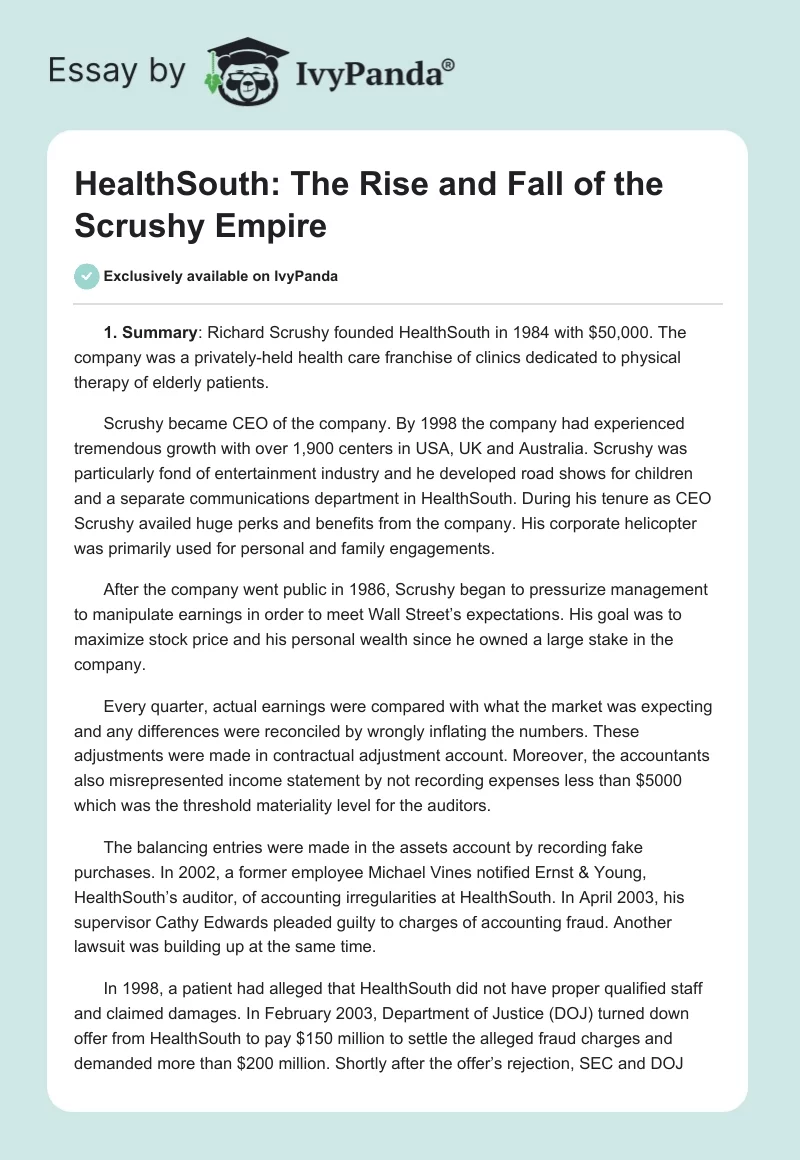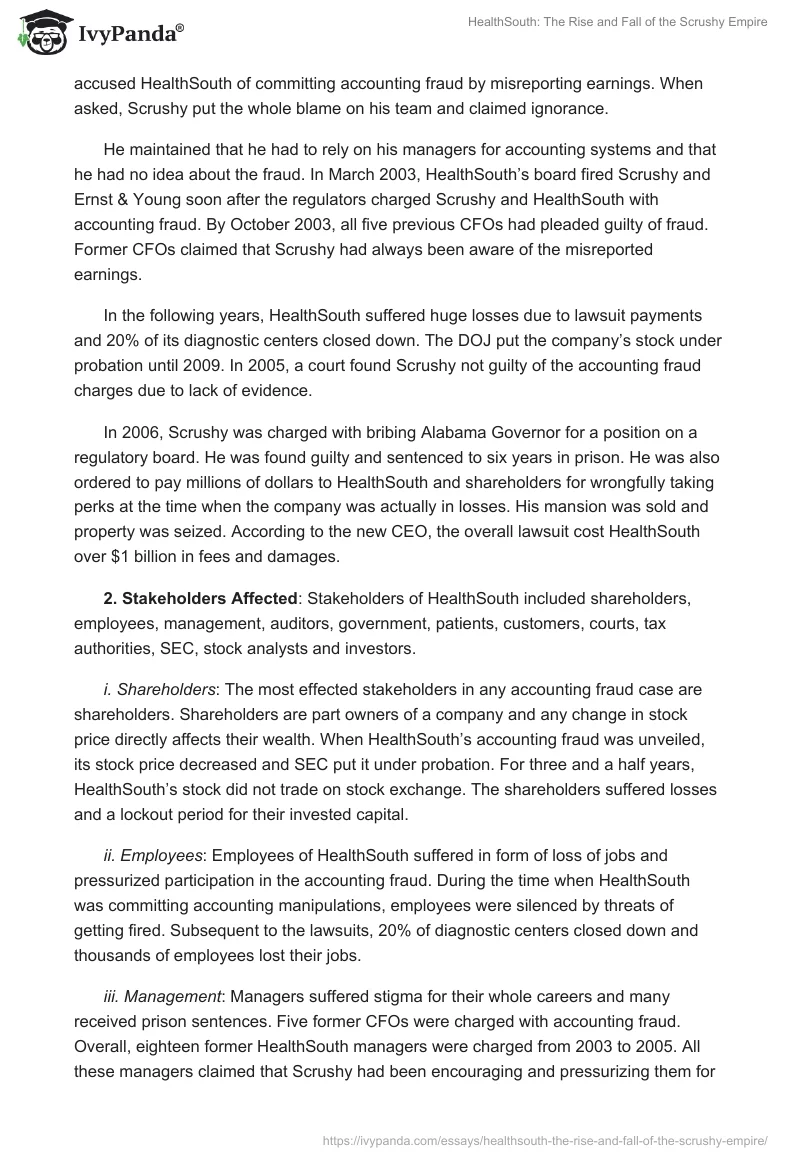1. Summary: Richard Scrushy founded HealthSouth in 1984 with $50,000. The company was a privately-held health care franchise of clinics dedicated to physical therapy of elderly patients.
Scrushy became CEO of the company. By 1998 the company had experienced tremendous growth with over 1,900 centers in USA, UK and Australia. Scrushy was particularly fond of entertainment industry and he developed road shows for children and a separate communications department in HealthSouth. During his tenure as CEO Scrushy availed huge perks and benefits from the company. His corporate helicopter was primarily used for personal and family engagements.
After the company went public in 1986, Scrushy began to pressurize management to manipulate earnings in order to meet Wall Street’s expectations. His goal was to maximize stock price and his personal wealth since he owned a large stake in the company.
Every quarter, actual earnings were compared with what the market was expecting and any differences were reconciled by wrongly inflating the numbers. These adjustments were made in contractual adjustment account. Moreover, the accountants also misrepresented income statement by not recording expenses less than $5000 which was the threshold materiality level for the auditors.
The balancing entries were made in the assets account by recording fake purchases. In 2002, a former employee Michael Vines notified Ernst & Young, HealthSouth’s auditor, of accounting irregularities at HealthSouth. In April 2003, his supervisor Cathy Edwards pleaded guilty to charges of accounting fraud. Another lawsuit was building up at the same time.
In 1998, a patient had alleged that HealthSouth did not have proper qualified staff and claimed damages. In February 2003, Department of Justice (DOJ) turned down offer from HealthSouth to pay $150 million to settle the alleged fraud charges and demanded more than $200 million. Shortly after the offer’s rejection, SEC and DOJ accused HealthSouth of committing accounting fraud by misreporting earnings. When asked, Scrushy put the whole blame on his team and claimed ignorance.
He maintained that he had to rely on his managers for accounting systems and that he had no idea about the fraud. In March 2003, HealthSouth’s board fired Scrushy and Ernst & Young soon after the regulators charged Scrushy and HealthSouth with accounting fraud. By October 2003, all five previous CFOs had pleaded guilty of fraud. Former CFOs claimed that Scrushy had always been aware of the misreported earnings.
In the following years, HealthSouth suffered huge losses due to lawsuit payments and 20% of its diagnostic centers closed down. The DOJ put the company’s stock under probation until 2009. In 2005, a court found Scrushy not guilty of the accounting fraud charges due to lack of evidence.
In 2006, Scrushy was charged with bribing Alabama Governor for a position on a regulatory board. He was found guilty and sentenced to six years in prison. He was also ordered to pay millions of dollars to HealthSouth and shareholders for wrongfully taking perks at the time when the company was actually in losses. His mansion was sold and property was seized. According to the new CEO, the overall lawsuit cost HealthSouth over $1 billion in fees and damages.
2. Stakeholders Affected: Stakeholders of HealthSouth included shareholders, employees, management, auditors, government, patients, customers, courts, tax authorities, SEC, stock analysts and investors.
i. Shareholders: The most effected stakeholders in any accounting fraud case are shareholders. Shareholders are part owners of a company and any change in stock price directly affects their wealth. When HealthSouth’s accounting fraud was unveiled, its stock price decreased and SEC put it under probation. For three and a half years, HealthSouth’s stock did not trade on stock exchange. The shareholders suffered losses and a lockout period for their invested capital.
ii. Employees: Employees of HealthSouth suffered in form of loss of jobs and pressurized participation in the accounting fraud. During the time when HealthSouth was committing accounting manipulations, employees were silenced by threats of getting fired. Subsequent to the lawsuits, 20% of diagnostic centers closed down and thousands of employees lost their jobs.
iii. Management: Managers suffered stigma for their whole careers and many received prison sentences. Five former CFOs were charged with accounting fraud. Overall, eighteen former HealthSouth managers were charged from 2003 to 2005. All these managers claimed that Scrushy had been encouraging and pressurizing them for reporting fake earnings. Although Scrushy was not found guilty of these charges in the court, the managers faced prison sentences.
iv. Auditors: HealthSouth’s auditor Ernst & Young faced one of the biggest accounting scandals in its history. The auditor admitted that it had received an anonymous letter in 1998 informing about accounting irregularities at HealthSouth but the firm did not take it seriously.
Later court statements suggested that Ernst & Young claimed ignorance of the matters, and that the management at HealthSouth continued to bypass all auditing procedures for almost six years. The board of HealthSouth fired Ernst & Young in March 2003. For the auditing firm, the scandal carried negative consequences. It faced court proceedings, filed for damage claims and suffered a tarnished reputation.
v. Government and SEC: Government and its relevant functions such as Department of Justice and SEC were actively involved in the HealthSouth accounting fraud lawsuit and investigations. DOJ charged Scrushy and the company with accounting fraud. Government pressed charges against Scrushy which the jury rejected due to lack of solid evidence. SEC was responsible for accepting false filing of quarterly earnings from HealthSouth for many years.
vi. Patients/Customers: Patients suffered significantly due to HealthSouth lawsuit. Almost 20% of diagnostic centers were closed down after the company suffered losses in 2004 and 2005. Patients who had been visiting those centers for many years had to face difficulties in continuing their treatment. Moreover, some patients claimed that HealthSouth centers did not have properly trained staff for physical therapy. One such damage claim forced HealthSouth to pay $325 million.
v. Courts: The justice system was probably the most important stakeholder in the HealthSouth scandal. In legal battles between corporations and the government, a misjudgment on part of the jury has deep and lasting consequences for the company under litigation, its employees and the management.
On the other hand, a correct judgment at right time can save a company from further fraud and losses. In case of HealthSouth, although the courts were unable to sentence Scrushy in accounting fraud, he was eventually sentenced in a bribing scandal for 6 years. His property was also seized on court’s order.
vi. Tax Authorities: Tax authorities become important stakeholder in case of earnings manipulations. HealthSouth reported excess earnings in its statements for many years. For all those years, excess tax was also paid to the government. Later when the fraud was revealed and the company went into losses, the tax authorities paid back $400 million as tax refund to the company for the period when it overpaid taxes.
vii. Stock Analysts and Traders: Scrushy had started manipulating earnings in order to meet market expectations. For all those years when HealthSouth was reporting fake earnings, stock analysts relied on the company’s audited statements and kept positive outlook for the company. For investment management firms and stock analysts who had recommended HealthSouth stock before 2003, the accounting scandal brought losses.
3. Prioritizing Stakeholders: An organization should prioritize stakeholders based on their stake in the company’s success and failure. Various stakeholders have different expectations from a company. Management should analyze expectations and interests of a particular stakeholder group and assess their relation to the company’s goals and objectives.
More important stakeholder group’s interests should be reflected in the company’s goals with more intensity. For a corporation, the most important stakeholder group should be the shareholders. Wealth of the shareholders increases or decreases based on stock price movement. A positive signal or good performance in a year may lead to increased stock price and higher returns. On the other hand, shareholders may not be the most important group for a non-profit public sector organization.
The second most important stakeholders group comprises employees and managers. Any changes in a company directly or indirectly affect the employees and the managers. In a manufacturing concern, health and safety of factory employees should be given importance. Environmental implications of large-scale industrial production have also included general public as a stakeholder group. Buyers, suppliers, government and regulatory authorities are all stakeholders who should be prioritized accordingly.
4. Optimal Solution: In order to satisfy needs of all stakeholder groups and recover its lost credibility, HealthSouth should adopt a strategy of setting goals and objectives based on expectations of the stakeholders. The board and the management should completely redefine strategy and engage various stakeholder groups in this exercise.
In first step, the management must define a hierarchy of stakeholder groups according to level of importance of each group. In second step, goals must be defined so that they coincide with interests of shareholders, employees, customers, government and general public at large.
For example, performance goals may include cutting costs, improving profitability, fair representation of accounts, training medical staff, setting up complaint management system for customers, fair treatment of employees and whistle blowing incentives. Moreover, in order to reinstate confidence of stock analysts and investors in HealthSouth, the management may share key points of future strategy with a select group of analyst firms.
5. Justification: When an organization’s goals and objectives are set in line with stakeholder expectations, the managers do not have much room for fulfilling their own interests. A relevant concept is called “agency cost”, which refers to managers’ use of company’s resources to satisfy their own interests.
Scrushy’s huge perks in HealthSouth were examples of agency costs. Furthermore, if goals are set in line with stakeholder expectations, periodic monitoring performance will naturally highlight any grey areas and identify management’s actions that do not satisfy any defined goals.
6. Stakeholders affected by the optimal solution: If HealthSouth adopts strategy of setting goals based on expectations of various stakeholder groups, the management will be able to monitor and control the performance according to those expectations. Shareholders will be satisfied by cutting costs and improving profitability. Government and tax authorities will be satisfied by fair presentation of earnings.
Employees will benefit by a value system based on equity and fairness. Customers and patients will benefit from quality services and a complaint management system. General public will be affected positively by HealthSouth’s payment of taxes based on correct earnings.
7. Steps to take in future: HealthSouth can proactively take several measures to avoid similar deliberate accounting frauds in future.
i. The management’s shareholding should be kept under check so that managers may not work with sole objective of maximizing their own wealth. A department may be set up to monitor managers’ trading of the company’s stocks. Red flags should be raised upon unusual activity. Similar checks should be placed on the CEO’s trading account.
ii. The company should appoint another audit firm as internal auditor in addition to the main external auditor. Presence of internal auditor minimizes risk of fabricating invoices and recording false transactions. Internal auditor may also develop accounting policies.
iii. HealthSouth should adopt a standard whistle-blowing policy. The employees should be encouraged to speak up against any wrong-doing rather than threatened. Whistle-blowing should be followed by defined rewards. Accounting irregularities may continue despite the best systems and controls unless there is whistle-blowing platform.
iv. Managers and employees responsible for recording financial transactions should be trained on international accounting standards as well as local laws relating to financial reporting. Regular evaluations may be conducted to assess employees’ understanding of the laws. Knowledge of the law along with a value system based on equity, fairness and honesty will develop a positive culture of fair representation.


